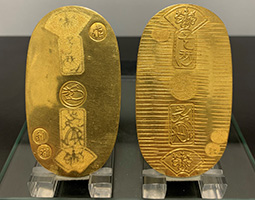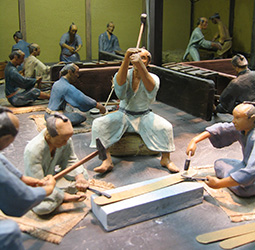October 2022
- English
- 日本語
The Tokugawa Shogunate’s Gold Mines

Section of a picture scroll depicting the manufacturing process from mining and smelting to koban production at the Sado Gold and Silver Mine

Front (right) and back (left) of a Shotoku-koban, a type of koban made on Sado Island (7.0 cm x 3.8 cm, early eighteenth century) 
A diorama of the process of hammering gold into sheets as depicted on a Sado Kinzan Gold Mine picture scroll (a Historic Site Sado Kinzan Gold Mine exhibit)

The Sado Kinzan Gold Mine on Sado Island (also known as Sadogashima Island) in the Sea of Japan was placed under the direct control of the Tokugawa Shogunate from the early seventeenth century, and the gold mined there supported the shogunate’s finances.

Sado Island is located in the Sea of Japan off the coast of Niigata Prefecture in northwestern Honshu. The island extends over an area of some 850 kilometers and its population numbers some 50,000 inhabitants (2020 statistics). Sado Island was once a major gold-mining area in Japan. During the first half of the seventeenth century, Japan accounted for around 20 percent of the world’s gold production, with almost half that volume produced on Sado Island.*
It was the discovery of a large vein of gold and silver at Aikawa in 1601 that led to Sado Island becoming a major gold producing area. Shortly after, in 1603, Tokugawa Ieyasu (1543–1616) established the Tokugawa Shogunate, placing Sado Island under its direct administration that same year and initiating the full-scale development of the Aikawa mine. What is now known as the Sado Kinzan Gold Mine would develop as an important mine that supported the finances of the Tokugawa Shogunate, which continued to rule Japan for the duration of the Edo period lasting some 260 years.
From the earliest days of the mine’s development, the Tokugawa Shogunate brought technicians with expertise in mining from other parts of Japan to Sado Island. Using the most advanced, albeit traditional, techniques available at the time, in all the processes from excavation until refinement of the metals, the purity of the refined gold produced at the Sado Kinzan Gold Mine was raised to 99.54 percent. This level of purity is reported to have been higher than in the West, where gold production was mechanized and involved the use of chemicals.*
Golden Sado Inc. manages the Historic Site Sado Kinzan Gold Mine, a sightseeing facility on Sado Island where visitors can see exhibits including a diorama of the Sado Kinzan Gold Mine in the Edo period and the remains of the actual mine shafts that were used. Official Nabata Sho says, “What sets the Sado Kinzan Gold Mine apart from other mines is that gold was produced here for an extended period of time using traditional non-mechanized methods. Whereas mines in other countries became increasingly mechanized from the seventeenth century, gold production at the Sado Kinzan Gold Mine was not mechanized during the Edo period, partly due to the shogunate’s strict regulations on contact with foreign countries. Despite this, constant technical improvements enabled the Sado Kinzan Gold Mine to continue producing high-quality gold, reaching such a high level of production that it was deemed the pinnacle of the manual gold production system.”
The gold mined on Sado Island was mainly formed into gold coins called koban. During the Edo period, the shogunate established a monetary system based on gold, silver, and copper coins. While a limited quantity of large-denomination oval gold coins known as oban was also produced, their primary function was ceremonial (see here), so the smaller sized koban played the more important role in the functioning of Japan’s monetary economy. In 1621, the shogunate established a facility on Sado Island for the making of gold coins, and koban were made there for the next two centuries.
The koban coins made on Sado Island also came to be used in trade overseas. Although the Tokugawa Shogunate had placed restrictions on contact with foreign countries, it continued to trade with China and the Netherlands, monopolizing the revenue from that trade. Initially, payments for the purchase of imported commodities such as raw silk and ceramics were made in silver. By the mid-seventeenth century, however, the large exodus of silver led to a prohibition on payments in silver. Instead, payments began to be made in koban, and it would be no exaggeration to say that koban became the mainstay of the shogunate’s trading currency thereafter. Visitors to the Historic Site Sado Kinzan Gold Mine museum can see koban on display as well as view exhibits explaining the production process.

From the Meiji period (1868–1912) onward following the fall of the Tokugawa Shogunate, the Sado Kinzan Gold Mine pushed ahead with mechanization, continuing to produce large quantities of gold and silver. However, from the second half of the twentieth century production volume gradually declined, with the mine finally closing in 1989.
Many remnants of the mine shafts and facilities remain in the Sado Kinzan Gold Mine, revealing the way the mine was in the Edo period. The Japanese government is recommending that the “Sado Island Gold Mines” be registered as a UNESCO World Heritage Site in recognition of the mine’s unique status in the world as an historical site of a production process encompassing all stages from the mining of metals to their refinement using traditional non-mechanized methods. The Sado Kinzan Gold Mine that once supported the Tokugawa Shogunate’s finances now forms an invaluable part of the world’s mining history.
* See the following Agency for Cultural Affairs materials: https://www.bunka.go.jp/seisaku/bunkazai/shokai/sekai_isan/suisenchu/pdf/93733301_01.pdf

